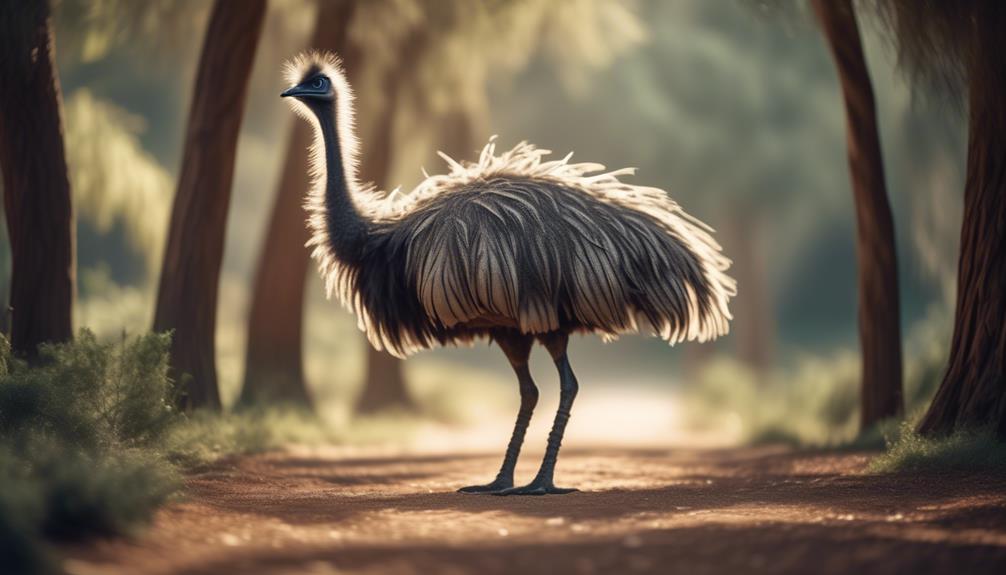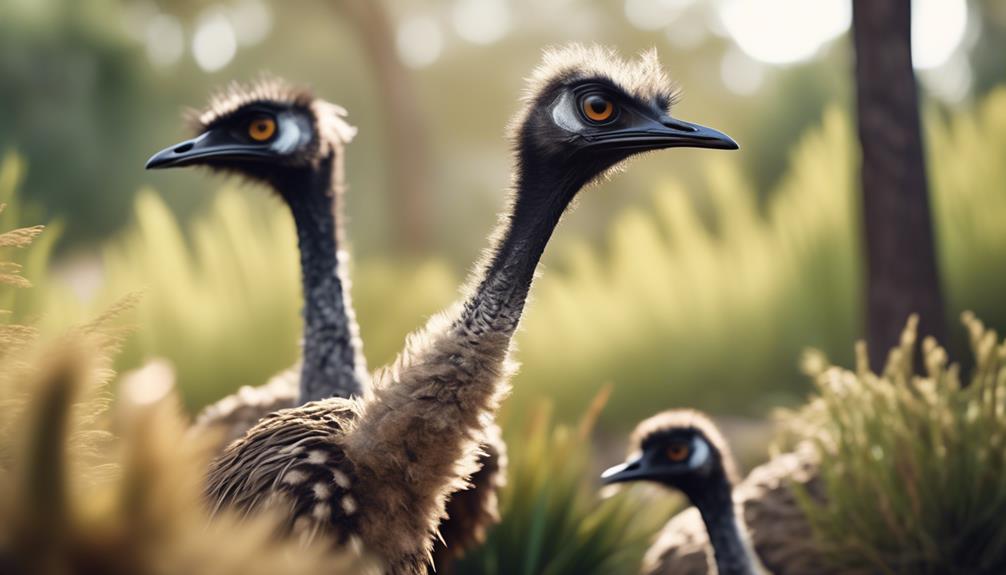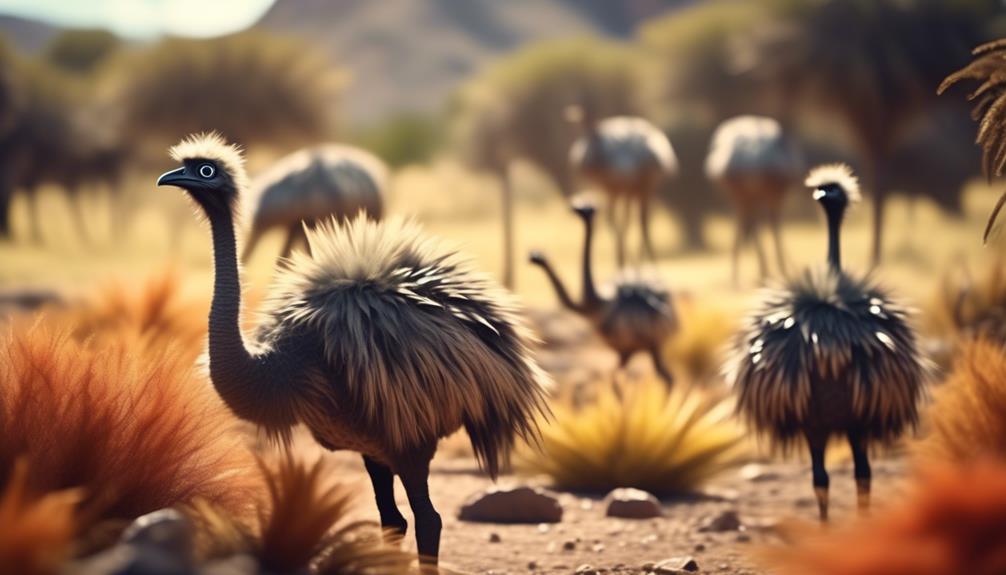
They say 'birds of a feather flock together,' but have you ever wondered just how diverse the avian world truly is?
Emus, those tall, flightless birds that roam the Australian outback, hold the key to unraveling the mysteries of avian evolution. These peculiar creatures have a lineage that stretches back millions of years, offering a glimpse into the ancient history of birds.
But it's not just their ancient lineage that makes them so fascinating. Emus also provide valuable insights into avian behavioral traits and the intricate workings of avian genomes.
As you delve into the world of emus, you'll discover how these living fossils hold the answers to understanding avian ancestors and the implications for future research and conservation efforts.
So, let's take a closer look at why emus are at the forefront of avian evolutionary studies.
Emu Characteristics and Adaptations

Emus, large flightless birds native to Australia, possess unique characteristics and adaptations that have allowed them to thrive in their environment. One of the most fascinating aspects of emus is their locomotion. These birds have long, powerful legs that enable them to run at impressive speeds, reaching up to 30 miles per hour. This efficient mode of transportation allows emus to cover large distances in search of food and water, making them well-suited to the vast Australian outback.
In terms of reproductive strategies, emus exhibit a fascinating approach. Unlike many other birds, emus don't form lifelong pair bonds. Instead, males actively court females by performing elaborate displays, such as puffing out their feathers and emitting deep booming calls. Once a female is impressed, she'll lay a clutch of large, dark-green eggs that are then incubated by the male. The male emu takes on the responsibility of incubation, diligently sitting on the eggs for approximately 56 days until they hatch. This unique reproductive strategy allows the female emu to move on and potentially mate with other males, while the male takes on the crucial task of ensuring the survival of their offspring.
Emus' locomotion and reproductive strategies are just two examples of the remarkable adaptations that have contributed to their successful existence in the Australian ecosystem. By understanding these unique characteristics, we gain valuable insights into avian evolution and the diverse strategies birds have developed to survive and thrive in different environments.
Ancient Lineage: Tracing Emus' Evolutionary History
Tracing the evolutionary history of emus reveals an ancient lineage that predates the existence of many other avian species. Through the study of their genetic makeup and fossil records, scientists have gained valuable insights into the evolution of birds as a whole.
Emus belong to the order Struthioniformes, which is one of the oldest and most primitive orders of birds. This ancient lineage diverged from other avian groups around 80 million years ago, making emus living relics of a bygone era. Their closest living relatives are cassowaries and kiwis, with whom they share common ancestors.
By examining the DNA of emus and comparing it to other bird species, researchers have been able to piece together the branching patterns of their lineage. These studies have provided crucial information about the relationships and evolutionary history of birds. For example, it has been discovered that emus share a common ancestor with the flightless moa, a group of extinct birds from New Zealand.
Fossil evidence has also shed light on the evolutionary journey of emus. Fossils of emu-like birds have been found in Australia dating back to the Pleistocene epoch, around 1.8 million years ago. These fossils reveal the gradual changes in morphology and adaptations that have occurred over time, providing further insights into emus' evolutionary story.
Behavioral Insights: Unraveling Avian Evolutionary Traits

To gain a deeper understanding of avian evolution, researchers have turned their attention to unraveling the behavioral insights that shed light on the evolutionary traits of birds. By studying the behavior of emus, one of the largest flightless birds in the world, scientists have made significant discoveries about avian communication and mating rituals.
Emu communication: Emus have a remarkable way of communicating through vocalizations and body postures. Their deep booming calls can be heard over long distances, and they use these calls to establish territory, attract mates, and communicate with their young. Observing their communication patterns has provided valuable insights into the evolution of avian vocalization and social behavior.
Mating rituals: Emus exhibit complex and fascinating mating rituals. Male emus engage in elaborate courtship displays, including drumming their wings and swaying their bodies. They also engage in competitive behaviors, such as chasing and wrestling with rival males. These behaviors have evolved over time to ensure reproductive success and have important implications for understanding the evolution of courtship behavior in birds.
Parental care: Emus are known for their exceptional parental care. After mating, females lay their eggs and entrust the males with the responsibility of incubating and raising the chicks. This unique behavior provides insights into the evolution of parental care strategies in birds and sheds light on the development of complex social systems.
Studying emu behavior has allowed researchers to uncover valuable information about avian evolution. By understanding the behavioral insights gained from emus, we can gain a deeper appreciation for the evolutionary traits that have shaped the diverse and fascinating world of birds.
Genetic Studies: Unveiling the Secrets of Avian Genomes
By delving into the world of avian genetics, scientists have unlocked a treasure trove of information, revealing the intricate secrets hidden within the genomes of birds. Through unraveling genomes, researchers have gained unprecedented insights into avian evolution and the fascinating adaptations that have shaped the diversity of bird species we see today.
One of the most powerful tools in studying avian genomes is DNA sequencing. This technique allows scientists to decipher the complete genetic code of a bird species, providing a blueprint for understanding its evolutionary history. By comparing the genomes of different bird species, scientists can identify genetic changes that have occurred over time and trace the branches of the avian evolutionary tree.
To give you a glimpse of the vast knowledge gained through genetic studies, let's take a look at a table showcasing the genetic diversity among some well-known bird families:
| Bird Family | Number of Species | Genetic Variability | Evolutionary Significance |
|---|---|---|---|
| Parrots | 393 | High | Diverse adaptations and vocal abilities |
| Raptors | 557 | Medium | Specialized hunting strategies and keen eyesight |
| Pigeons | 312 | Low | Remarkable homing abilities and cooing vocalizations |
| Hummingbirds | 338 | High | Unique flight capabilities and rapid metabolism |
| Waterfowl | 176 | Medium | Adaptations for aquatic lifestyles and migratory behavior |
This table is just a snapshot of the vast genetic diversity found within the avian world. By studying the genomes of different bird species, scientists can uncover the genetic mechanisms that have driven the evolution of specific traits, such as flight, vocalization, and migration. These genetic insights provide a deeper understanding of the intricate processes that have shaped avian evolution over millions of years.
Emus as Living Fossils: Understanding Avian Ancestors

Through the exploration of avian genomes, scientists have gained invaluable insights into the evolutionary history of birds, including the remarkable discovery of emus as living fossils, providing a unique window into understanding avian ancestors.
- Emus, with their distinctive appearance and ancient lineage, evoke a sense of wonder and curiosity. These flightless birds have remained relatively unchanged for millions of years, offering us a glimpse into the past and a deeper understanding of avian evolution.
- The study of emus as living fossils allows scientists to reconstruct the characteristics and behaviors of their ancestors. By comparing the genetic makeup of emus with that of their extinct relatives, we can piece together the puzzle of avian lineage and trace the evolutionary path that led to the diverse bird species we see today.
- Emus also serve as a living link between birds and their reptilian ancestors. Their primitive traits, such as vestigial wings and large, dinosaur-like feet, provide insight into the transition from dinosaurs to birds. By studying emus, we can better understand the evolutionary processes that shaped avian anatomy and behavior over millions of years.
Implications for Conservation and Future Research
The implications for conservation and future research regarding emus as living fossils are significant, as they provide valuable insights into the preservation of avian biodiversity and the understanding of evolutionary processes.
Emus, being the only living members of their lineage, offer a unique opportunity to study the characteristics and adaptations of their ancient ancestors. This knowledge can inform conservation strategies aimed at protecting other threatened or endangered avian species.
By studying the genetic makeup, anatomy, and behavior of emus, researchers can identify key traits that have contributed to their survival over millions of years. This information can be applied to the conservation of other avian species, helping to develop targeted management plans that focus on preserving important genetic diversity and habitat requirements.
Furthermore, the study of emus as living fossils has the potential to shed light on the mechanisms of evolutionary processes. By comparing the genetic sequences of emus with those of their extinct relatives, scientists can gain insights into the genetic changes that have occurred over time. This knowledge can contribute to our understanding of how species adapt to changing environments and evolve over generations.
In terms of future research, the potential applications are vast. Emus can serve as a model species for studying the effects of climate change on avian populations, providing insights into how these birds may respond to shifting environments. Additionally, by investigating the unique physiological characteristics of emus, such as their ability to go long periods without water, researchers may uncover valuable information that could be used in the development of biomimetic technologies.
Frequently Asked Questions
How Do Emus Communicate With Each Other?
Emus communicate through a combination of vocalizations and visual displays. Their unique vocalizations include grunts, booms, and hisses, while their visual displays involve raising their feathers and necks. These communication methods play a crucial role in their social interactions and establishing territories.
What Is the Lifespan of an Emu in the Wild?
In the wild, emus live for about 10-20 years. Their lifespan is influenced by various factors such as emu migration patterns and their diet, which primarily consists of vegetation.
How Do Emus Defend Themselves Against Predators?
Emus defend themselves against predators using a variety of defensive mechanisms and predator avoidance techniques. These include their large size, powerful legs for kicking, and their ability to run at high speeds.
Do Emus Have Any Unique Reproductive Behaviors?
Emus exhibit unique reproductive behaviors, engaging in elaborate courtship rituals and displaying complex mating habits. These fascinating actions shed light on the intricacies of emu reproductive strategies and contribute to our understanding of avian evolution.
Are Emus Found in Any Other Parts of the World Besides Australia?
Emus are not found in North America or Europe. They are native to Australia, where they have adapted to the unique environment. Understanding their distribution and migration patterns can provide insights into avian evolution.
Conclusion
In conclusion, exploring the evolutionary history of emus has provided valuable insights into avian evolution. These fascinating creatures, with their unique characteristics and adaptations, serve as living fossils, connecting us to the ancestors of modern birds.
Through behavioral observations and genetic studies, we've unraveled the secrets of avian genomes and gained a deeper understanding of the traits that have shaped bird species over time.
The emu's significance in conservation and future research can't be overstated; they hold the key to unlocking the mysteries of avian evolution, like a brilliantly colored feather revealing the hidden beauty of a masterpiece.




